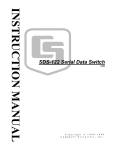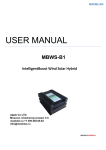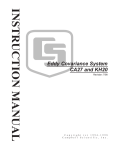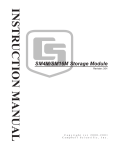Download Campbell MD9 Instruction manual
Transcript
INSTRUCTION MANUAL MD9 Multidrop Interface Revision: 5/03 C o p y r i g h t ( c ) 1 9 8 7 - 2 0 0 3 C a m p b e l l S c i e n t i f i c , I n c . Warranty and Assistance The MD9 MULTIDROP INTERFACE is warranted by CAMPBELL SCIENTIFIC, INC. to be free from defects in materials and workmanship under normal use and service for twelve (12) months from date of shipment unless specified otherwise. Batteries have no warranty. CAMPBELL SCIENTIFIC, INC.'s obligation under this warranty is limited to repairing or replacing (at CAMPBELL SCIENTIFIC, INC.'s option) defective products. The customer shall assume all costs of removing, reinstalling, and shipping defective products to CAMPBELL SCIENTIFIC, INC. CAMPBELL SCIENTIFIC, INC. will return such products by surface carrier prepaid. This warranty shall not apply to any CAMPBELL SCIENTIFIC, INC. products which have been subjected to modification, misuse, neglect, accidents of nature, or shipping damage. This warranty is in lieu of all other warranties, expressed or implied, including warranties of merchantability or fitness for a particular purpose. CAMPBELL SCIENTIFIC, INC. is not liable for special, indirect, incidental, or consequential damages. Products may not be returned without prior authorization. The following contact information is for US and International customers residing in countries served by Campbell Scientific, Inc. directly. Affiliate companies handle repairs for customers within their territories. Please visit www.campbellsci.com to determine which Campbell Scientific company serves your country. To obtain a Returned Materials Authorization (RMA), contact CAMPBELL SCIENTIFIC, INC., phone (435) 753-2342. After an applications engineer determines the nature of the problem, an RMA number will be issued. Please write this number clearly on the outside of the shipping container. CAMPBELL SCIENTIFIC's shipping address is: CAMPBELL SCIENTIFIC, INC. RMA#_____ 815 West 1800 North Logan, Utah 84321-1784 CAMPBELL SCIENTIFIC, INC. does not accept collect calls. MD9 Multidrop Interface Table of Contents PDF viewers note: These page numbers refer to the printed version of this document. Use the Adobe Acrobat® bookmarks tab for links to specific sections. 1. Introduction.................................................................1 2. System Description ....................................................1 3. Software and Datalogger Compatibility ....................3 4. ID and Baud Rate Selection .......................................3 5. Maximum Number of Dataloggers and Coax Length...........................................................4 6. Telephone to MD9 Network ........................................5 7. Operation.....................................................................6 A. Cable Specifications and Source References...... A-1 B. Break/Address Timing ........................................... B-1 C. Setting the Station ID ............................................. C-1 D. SC532A ................................................................... D-1 Tables 1-1 Specifications ...........................................................................................1 4-1 ID Settings for MD9 Connected to Computer ..........................................4 Figures 1-1 MD9 Multidrop Interface .........................................................................2 2-1 System Description...................................................................................3 i MD9 Multidrop Interface Table of Contents 4-1 ID Switch and Baud Rate Selection Jumpers........................................... 4 6-1 Telephone to MD9 Conversion................................................................ 6 B-1 Break/Address Timing Diagram.......................................................... B-1 This is a blank page. ii MD9 Multidrop Interface 1. Introduction The MD9 Multidrop Interface functions as a direct wire link between a computer and a Campbell Scientific datalogger via coax cable. MD9s may be networked thereby permitting a computer to address and communicate with up to 254 dataloggers. Total coax length may be up to 3 miles when fewer dataloggers are used. With the communication link initiated and controlled by an IBM PC or clone using Campbell Scientific's telecommunication software, the operation of the MD9 in the system is transparent to the user. Call back from a remote datalogger via MD9 is not possible. TABLE 1-1. Specifications Size: 6.5 X 3.5 X 1.25 in. Weight: 5 oz. Accessories: SC12 cable, BNC "T" connector Voltage: 5 Volts from datalogger or SC532(A) Current: State 0 "Standby" State 1 "Active" (when transmit line drives network) State 2 "Sleep" State 3 Pull ring line & buffer bytes 1.2 mA 17 mA 80 mA 3 mA 17 mA Temperature range: -25 to +50oC Baud rates: 9600, 1200, 300 Carrier frequency: 1.2 MHz Communication cable: RG59/U Coax Cable connector: BNC 2. System Description The block diagram in Figure 2-1 depicts the connection of a computer to a network of Campbell Scientific dataloggers using MD9s. Connection of the MD9 to the computer's RS-232 SIO port is made via the SC532(A) 9 Pin Peripheral to RS-232 Interface. The SC532(A) supplies +5 VDC power to the MD9 as well as converts the MD9's CMOS voltage levels to voltage levels consistent with RS-232 requirements. A computer with the PC201 card installed could use the SC925 Cable to connect directly to the MD9. 1 MD9 Multidrop Interface The MD9 at the computer is connected to one or more other MD9s with coax cable terminated with BNC connectors. Refer to Appendix A for cable specifications and source references. The MD9 at the datalogger is connected via an SC12 cable (supplied with the MD9) and is powered from the datalogger SERIAL I/O port. Each MD9 includes a BNC "T" connector to allow for coax in/ coax out. "T" connectors on MD9s at the beginning (computer) and end (last datalogger) of the network must be terminated with 75 ohm Coax Terminators in order to prevent signal reflection from one end of the cable to the other. Place terminators on the ends of the main cable only. Any branch cables from the main cable to an MD9 should be less than 10 feet in length. No terminator is used on the T connector at the MD9 on a branch. (Figure 2-1). NOTE There are two ground terminals located between the Serial I/O and Coax Connectors on the MD9. When installing the MD9, a 16AWG or heavier wire should be connected from earth ground to one of these terminals. FIGURE 1-1. MD9 Multidrop Interface 2 MD9 Multidrop Interface FIGURE 2-1. System Description 3. Software and Datalogger Compatibility PC208 Software Index #5348-00 or higher is required for use with MD9s. Customers using older software may purchase a software update for a nominal charge by contacting Campbell Scientific. The following dataloggers may be used in an MD9 network. CR10 21X 700X all SN6195 or higher Control Module SN1670 or higher 21Xs and 700Xs with lower SNs require a resistor modification which permits the respective 5 Volt power supplies to source enough current to operate an MD9. Contact Campbell Scientific customer service if your datalogger requires this modification. 4. ID and Baud Rate Selection Each MD9 in an MD9 network must have a unique ID. The ID is set by the ID select switch (Figure 4-1). This switch is located under the cover, and can be accessed by removal of the four cover screws. Appendix C gives a complete list of ID and switch settings. 3 MD9 Multidrop Interface TABLE 4-1. ID Settings for MD9 Connected to Computer Software Used ID Dos PC208 (GraphTerm, Telcom, and PC208E) Windows PC208W (Tcom) 1 - 254 255 NOTE An MD9 with the ID set to 255 can be used with the DOS PC208 by adding a pound sign (#) to the end of the base MD9 dialing path in the PC208 station file. This is useful if PC208 and PC208W must be used on the same MD9 network. NOTE Address 255 is also used when the MD9 is connected to a telephone modem (Section 6). MD9s are shipped with the Baud Rate Selection Jumpers set at 9600 Baud. Other baud rates may be selected when necessary. All MD9s in a system must be set at the SAME baud rate. 9600 Baud 1200 Baud 300 Baud A-B Short A-B Open A-B Short C-D Short C-D Short C-D Open FIGURE 4-1. ID Switch and Baud Rate Selection Jumpers 5. Maximum Number of Dataloggers and Coax Length The maximum coax run that can operate reliably is dependent on the signal loss due to the type of wire selected and the load placed on the system by each MD9 and coax terminator. The total signal loss in an MD9 system cannot be greater than 50 db. Each MD9 attenuates the signal by 0.2 db. Each 100 ft. of Belden 9100 coax cable attenuates the signal by 0.6 db. The terminator pair account for a 6 db loss. A quick calculation shows that a network of 34 dataloggers on 5,000 feet of coax is a workable system. 4 MD9 Multidrop Interface 35 MD9s @ 0.2 db 5,000 ft. @ 0.6 db/ 100 ft. Coax terminator pair 7 db (including MD9 at PC) 30 db 6 db Total Signal Loss 43 db 6. Telephone to MD9 Network It is possible to access an MD9 network via telephone when the network is miles from the PC. See Figure 6-1. A Campbell Scientific Model COM200 Telephone Modem is used in conjunction with a Model PS512M 12 and 5 Volt Charging Regulator to communicate with an MD9. The COM200 and the MD9 are both supplied with a 9 pin SC12 cable suitable for connection to the PS512M. The PS512M provides 5 volts for system operation and performs the function of a null modem (the COM200 & MD9 are both "modem" devices). The PS512M requires a 12 Volt battery for operation and contains a charging circuit to maintain the battery voltage level. The PS512M includes an AC wall transformer for AC operation A solar panel (optional) may be used if AC is unavailable. NOTE A PS512M with a serial number less than 1712 does not supply 12 volts to the COM200 modem. Use adapter 10704 or connect 12 volts and ground to the 12 volts and ground terminals on the COM200. The MD9 connected to the COM200 telephone modem must have the ID switch set to 255 (all switches open). When creating the station file in PC208 the base telephone with phone number is entered first and the MD9 with ID is entered second. When configuring the network in PC208W a modem device (9600 baud) is added to a COM port, the MD9 device attaches to the Modem, and the datalogger to the MD9. The base phone number is entered in the MD9 window and the “Switch Setting of Remote MD9” (ID) is entered in the datalogger window. NOTE In order to make measurements at the telephone to MD9 location, a datalogger with it's own MD9 is required. 5 MD9 Multidrop Interface COM200 The null modem on the PS512M has two 9-pin connectors. The SC12 cable from the COM200 is connected to either connector and the SC12 from the MD9 is connected to the other. FIGURE 6-1. Telephone to MD9 Conversion 7. Operation Communication between the computer and a datalogger is initiated and controlled by the computer. The MD9 at the computer is activated when Pin 20, Data Terminal Ready (DTR), is pulled high on the computer's I/O port. The signal is passed through the SC532(A) and in turn brings Pin 5 Modem Enable (ME) high on the MD9s I/O port. When the ME line is pulled high, the MD9 goes from State 0 standby to State 1 active. Once in State 1, any information transmitted by the computer is passed on to the coax network. This remains true until the DTR and ME line are pulled low and the MD9 reverts to State 0. Immediately after the computer enables its MD9 it must send a "BREAK" command followed by the "ADDRESS" of the destination MD9. See the timing diagram in Appendix C. Upon detecting activity on the coax line, remote MD9s convert from State 0 to State 2. State 2 is a sleep mode in which the MD9 begins a timing routine to determine if a BREAK has occurred. If a BREAK is not detected, the MD9 returns to State 0. If a BREAK is detected, all remote Multidrop Interfaces capture and read the ADDRESS. The properly addressed MD9 progresses to State 3 in which it pulls the datalogger ring line and buffers any bytes of information which followed the ADDRESS. All other remote MD9s alternate between States 0 and 2 trying to identify whether the continuing activity on the network is a new BREAK. When the datalogger detects the ring line signal it enters its telecommunication mode and pulls its ME line high causing the MD9 to enter State 1. The link is 6 MD9 Multidrop Interface now complete. The computer can now send several carriage returns which permits the datalogger to synchronize at the same baud rate. Once the datalogger baud rate has been synchronized, data retrieval, data monitoring and re-programming of the datalogger can be carried out. To terminate communications with a datalogger, use the E command (followed by a carriage return) listed in the datalogger instruction manual. The datalogger will respond by lowering the ME line to its MD9 causing it to return to State 0. In order to activate the next datalogger station, a BREAK and the next ADDRESS is sent by the computer. This procedure continues until all dataloggers in a network have been interrogated. When all data for a particular time period has been collected and stored by the computer, the computer's DTR line is released causing the local MD9 to return to State 0. An MD9 used in the telephone conversion must be operated in the "Protocol Mode". In the Protocol Mode, the MD9 communicates with the computer via the phone and controls activity on the coax network generating the "Break" command, etc. The Protocol Mode is activated when the MD9 ID switch is set to 255 (all switches OPEN). When a station file is set up using PC208 software and the MD9 is not entered as the FIRST "Interface Device", the software assumes the MD9 at the phone modem is in the Protocol Mode. If both conditions are met the MD9 ID set to 255 and the MD9 is not the first Interface Device the telephone to MD9 conversion is transparent to the user. 7 MD9 Multidrop Interface This is a blank page. 8 Appendix A. Cable Specifications and Source References Belden 1505A: Conductor: 20 AWG solid copper (.032” ∅) Jacket Material: PVC Jacket O.D.: .235 Shield: Braided tinned copper (100% coverage) Resistance: 10Ω/1000’ Capacitance: 16.2pf/ft. Impedance: 75 Ohms Attenuation at 1 MHz: 0.29 db/100’ Belden Wire and Cable P.O. Box 1980 Richmond, IN 47375 317-983-5200 A-1 This is a blank page. Appendix B. Break/Address Timing A BREAK consists of continuous spacing for time greater than 10 times the inverse of BR (baud rate). The BREAK is followed by a marking period and single byte ADDRESS. The marking time must be greater than one times the inverse of BR and the marking time and ADDRESS must be completed within 100 msec. This is to say that a 9600 baud, the BREAK must be greater than 1.1 m sec followed by marking for 105 usec. The 8 bit single character ADDRESS (least significant bit first) is then completed within 100 msec after the end of BREAK. FIGURE B-1. Break/Address Timing Diagram B-1 This is a blank page. Appendix C. Setting the Station ID Each MD9, including the one in the MD9 base station, must have a unique Station ID. Following is a list of all possible Station IDs with the corresponding setting of the dip switches. Here, 1 represents open and 0 is closed. When a station is configured for phone to MD9, PC208 DOS software cannot recognize an MD9 address greater than 127. ID SWITCHES 5678 1234 ID SWITCHES 1234 5678 1 2 3 4 5 6 7 8 9 10 11 12 13 14 15 16 17 18 19 20 21 22 23 24 25 26 27 28 29 30 32 33 34 35 36 37 38 39 1000 0100 1100 0010 1010 0110 1110 0001 1001 0101 1101 0011 1011 0111 1111 0000 1000 0100 1100 0010 1010 0110 1110 0001 1001 0101 1101 0011 1011 0111 0000 1000 0100 1100 0010 1010 0110 1110 43 44 45 46 47 48 49 50 51 52 53 54 55 56 57 58 59 60 61 62 63 64 65 66 67 68 69 70 71 72 74 75 76 77 78 79 80 81 82 1101 0011 1011 0111 1111 0000 1000 0100 1100 0010 1010 0110 1110 0001 1001 0101 1101 0011 1011 0111 1111 0000 1000 0100 1100 0010 1010 0110 1110 0001 0101 1101 0011 1011 0111 1111 0000 1000 0100 0000 0000 0000 0000 0000 0000 0000 0000 0000 0000 0000 0000 0000 0000 0000 1000 1000 1000 1000 1000 1000 1000 1000 1000 1000 1000 1000 1000 1000 1000 0100 0100 0100 0100 0100 0100 0100 0100 0100 0100 0100 0100 0100 1100 1100 1100 1100 1100 1100 1100 1100 1100 1100 1100 1100 1100 1100 1100 1100 0010 0010 0010 0010 0010 0010 0010 0010 0010 0010 0010 0010 0010 0010 0010 1010 1010 1010 ID 86 87 88 89 90 91 92 93 94 95 96 97 98 99 100 101 102 103 104 105 106 107 108 109 110 111 112 113 114 115 117 118 119 120 121 122 123 124 125 SWITCHES 1234 5678 0110 1110 0001 1001 0101 1101 0011 1011 0111 1111 0000 1000 0100 1100 0010 1010 0110 1110 0001 1001 0101 1101 0011 1011 0111 1111 0000 1000 0100 1100 1010 0110 1110 0001 1001 0101 1101 0011 1011 1010 1010 1010 1010 1010 1010 1010 1010 1010 1010 0110 0110 0110 0110 0110 0110 0110 0110 0110 0110 0110 0110 0110 0110 0110 0110 1110 1110 1110 1110 1110 1110 1110 1110 1110 1110 1110 1110 1110 C-1 Appendix C. Setting the Station ID ID 40 41 42 129 130 131 132 133 134 135 136 137 138 139 140 141 142 143 144 145 146 147 148 149 150 151 152 153 154 155 156 157 158 159 160 161 162 163 164 165 166 167 168 169 170 171 C-2 SWITCHES 5678 1234 0001 1001 0101 1000 0100 1100 0010 1010 0110 1110 0001 1001 0101 1101 0011 1011 0111 1111 0000 1000 0100 1100 0010 1010 0110 1110 0001 1001 0101 1101 0011 1011 0111 1111 0000 1000 0100 1100 0010 1010 0110 1110 0001 1001 0101 1101 0100 0100 0100 0001 0001 0001 0001 0001 0001 0001 0001 0001 0001 0001 0001 0001 0001 0001 1001 1001 1001 1001 1001 1001 1001 1001 1001 1001 1001 1001 1001 1001 1001 1001 0101 0101 0101 0101 0101 0101 0101 0101 0101 0101 0101 0101 ID 83 84 85 172 173 174 175 176 177 178 179 180 181 182 183 184 185 186 187 188 189 190 191 192 193 194 195 196 197 198 199 200 201 202 203 204 205 206 207 208 209 210 211 212 213 214 SWITCHES 1234 5678 1100 0010 1010 0011 1011 0111 1111 0000 1000 0100 1100 0010 1010 0110 1110 0001 1001 0101 1101 0011 1011 0111 1111 0000 1000 0100 1100 0010 1010 0110 1110 0001 1001 0101 1101 0011 1011 0111 1111 0000 1000 0100 1100 0010 1010 0110 1010 1010 1010 0101 0101 0101 0101 1101 1101 1101 1101 1101 1101 1101 1101 1101 1101 1101 1101 1101 1101 1101 1101 0011 0011 0011 0011 0011 0011 0011 0011 0011 0011 0011 0011 0011 0011 0011 0011 1011 1011 1011 1011 1011 1011 1011 ID 126 127 128 215 216 217 218 219 220 221 222 223 224 225 226 227 228 229 230 231 232 233 234 235 236 237 238 239 240 241 242 243 244 245 246 247 248 249 250 251 252 253 254 255 SWITCHES 1234 5678 0111 1111 0000 1110 0001 1001 0101 1101 0011 1011 0111 1111 0000 1000 0100 1100 0010 1010 0110 1110 0001 1001 0101 1101 0011 1011 0111 1111 0000 1000 0100 1100 0010 1010 0110 1110 0001 1001 0101 1101 0011 1011 0111 1111 1110 1110 0001 1011 1011 1011 1011 1011 1011 1011 1011 1011 0111 0111 0111 0111 0111 0111 0111 0111 0111 0111 0111 0111 0111 0111 0111 0111 1111 1111 1111 1111 1111 1111 1111 1111 1111 1111 1111 1111 1111 1111 1111 1111 Appendix D. SC532A The SC532A differs from the SC532 in three ways: 1. 2. 3. Provides 12 V on PERIPHERAL Port pin 8 “PROGRAM” mode Jack on SC532A POWER input The SC532A supplies 12 VDC via PERIPHERAL connector pin 8 for the purpose of powering 12 V peripherals. The SC532A’s internal jumper selects “SC532” or “PROG” mode. For the MD9 leave the jumper in the factory default position of “SC532.” “PROG” is a special mode for satellite transmitters only. The SC532A has a POWER jack allowing convenient replacement in the event of AC adapter failure (see CAUTION below). The jack also facilitates operating the SC532A from datalogger power at remote sites by using optional field cable (item number 14020) in place of the AC adapter. Simply plug the cable’s DB9 connector into the datalogger’s CS I/O port for 12 V power. If you have an earlier datalogger lacking 12 V on CS I/O port pin 8 (DVM test between paper-clip inserted in pin 8 and GND) the field cable can be modified to connect to the datalogger’s power terminals as follows: 1. 2. 3. 4. 5. Unplug field cable from datalogger and SC532A. Cut off DB9 connector. Remove cable sheath exposing positive (RED) wire and negative (BLACK) wire 2 inches back. Strip ¼ inch of insulation from each wire and tin ends. Connect RED wire to datalogger “12 V” and BLACK wire to datalogger power ground terminal. The correct barrel connector polarity is (+) on the inner bore and (−) on the outer sleeve. The MD9 requires that a minimum of 6 VDC @ 90 mA be supplied to the SC532A POWER jack from AC adapter or field cable. The maximum voltage that can be safely applied to the SC532A POWER jack is 17 VDC. CAUTION Before plugging the power connector into the SC532A, if you have 1) cut off optional field cable’s DB9, 2) replaced the factory AC adapter, or 3) built your own dc power cable, make sure that the voltage polarity is correct on the barrel connector. Application of REVERSED POLARITY power to the SC532A can damage the SC532A, datalogger, and peripheral (not covered under warranty)! Barrel connector inner bore (+) Barrel connector outer sleeve (−) The maximum POWER input voltage is 17 VDC! D-1 This is a blank page. This is a blank page. Campbell Scientific Companies Campbell Scientific, Inc. (CSI) 815 West 1800 North Logan, Utah 84321 UNITED STATES www.campbellsci.com [email protected] Campbell Scientific Africa Pty. Ltd. (CSAf) PO Box 2450 Somerset West 7129 SOUTH AFRICA www.csafrica.co.za [email protected] Campbell Scientific Australia Pty. Ltd. (CSA) PO Box 444 Thuringowa Central QLD 4812 AUSTRALIA www.campbellsci.com.au [email protected] Campbell Scientific do Brazil Ltda. (CSB) Rua Luisa Crapsi Orsi, 15 Butantã CEP: 005543-000 São Paulo SP BRAZIL www.campbellsci.com.br [email protected] Campbell Scientific Canada Corp. (CSC) 11564 - 149th Street NW Edmonton, Alberta T5M 1W7 CANADA www.campbellsci.ca [email protected] Campbell Scientific Ltd. (CSL) Campbell Park 80 Hathern Road Shepshed, Loughborough LE12 9GX UNITED KINGDOM www.campbellsci.co.uk [email protected] Campbell Scientific Ltd. (France) Miniparc du Verger - Bat. H 1, rue de Terre Neuve - Les Ulis 91967 COURTABOEUF CEDEX FRANCE www.campbellsci.fr [email protected] Campbell Scientific Spain, S. L. Psg. Font 14, local 8 08013 Barcelona SPAIN www.campbellsci.es [email protected] Please visit www.campbellsci.com to obtain contact information for your local US or International representative.


































